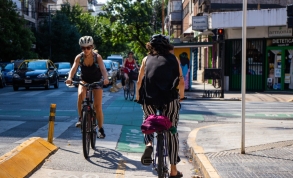Related Content

Physical activity
Active travel cuts carbon and improves health in New Zealand

Physical activity
In 2001, Tokyo introduced a new regulation as part of the Tokyo Metropolitan Environmental Security Ordinance to encourage businesses to shift to low-emission, fuel-efficient vehicles. The regulation requires businesses with 30 or more vehicles to submit a Vehicle Emission Reduction Plan, outlining their steps to reduce greenhouse gas emissions, air pollution and fuel consumption, as well as providing an annual performance report. More than 1,500 businesses reported their plans in Fiscal Year (FY) 2021 and 440,000 tonnes of CO2, 1,367 tonnes of NOx and 49 tonnes of PM were reduced compared to FY 2016.
Tokyo has implemented several measures to tackle the environmental problems caused by the rapid industrialisation and the mass adoption of automobiles that occurred since the post-World War II economic boom. In the 1970s, the city implemented various measures to regulate air pollutants from factories. As air pollution increased with more traffic in the early 2000s, Tokyo introduced regulations for automobiles, such as regulating exhaust from large diesel vehicles, including trucks and buses.
In 2001, the Tokyo Metropolitan Government (TMG) introduced a regulation requiring businesses with 30 or more vehicles to submit a Vehicle Emission Reduction Plan and an annual performance report, with the aim of encouraging businesses to shift to low-emission, fuel-efficient vehicles. More than 1,500 businesses submitted five-year plans and annual reports, allowing the TMG to understand the reductions of CO2, NOx and PM emissions achieved by each business covered by the program.
Businesses were required to submit the following information:
The total emissions of the businesses covered by the Vehicle Emission Reduction Program decreased by 440,000 tonnes of CO2, 1,367 tonnes of NOx, and 49 tonnes of PM in FY2021 compared to FY2016. These reductions are calculated by the TMG based on the reports submitted by the businesses. The CO2 reduction is calculated from the fuel consumption of each vehicle used by each business, and the NOx and PM reductions are calculated from the vehicle type and mileage used by each business.
Whilst businesses with 30 or more vehicles are required to submit five-year plans and annual reports and are encouraged to implement environmentally-friendly actions such as introducing low-emission and fuel-efficient vehicles and implementing eco-driving, only the submission of plans and reports is regulated and businesses are not obliged to implement concrete changes.
Under Tokyo’s Metropolitan ordinance, businesses with 200 vehicles or more are required to have a specific proportion of their vehicle fleet consisting of low-emission and fuel-efficient vehicles. From 2022, businesses with 200 vehicles or more are required to have their vehicle fleet consisting of 30% (previously 15%) low-emission and fuel-efficient vehicles, and 20% of their passenger car fleet must be Battery Electric Vehicles (BEV), Plug-in Hybrid Electric Vehicles (PHEV), Fuel Cell Vehicle (FCV), or hybrid cars. Applicable vehicle types are designated by the TMG. The TMG further selects 120 businesses each year based on their submitted plans and reports and provides them with guidance and advice on emission reduction actions. This feedback includes information on CO2 emissions, the trend of the ratio of low-emission and fuel-efficient vehicles over time, as well as comparisons with both similar-sized companies and companies in the same industry. The TMG also provides referrals to the available financial support measures for qualifying businesses.
There are currently no plans to scale up the Vehicle Emission Reduction Program, however, businesses with large vehicle fleets making the shift to low-emission and fuel-efficient vehicles can have a large impact on CO2 and air pollution reduction in Tokyo. Tokyo's transport sector accounts for about 20% of the city's total CO2 emissions, 78% of which is attributable to automobiles. Moving to low-or zero-emission vehicles would therefore greatly decrease the CO2 emissions of the transport sector and improve air quality in the city.